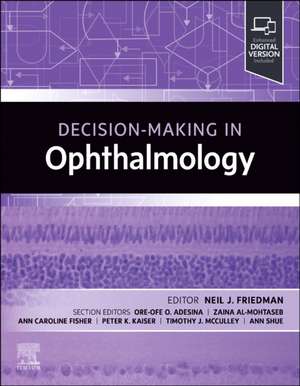Decision-Making in Ophthalmology: Decision Making Series: Decision Making
Editat de Neil J. Friedmanen Limba Engleză Paperback – 8 aug 2025
Preț: 605.13 lei
Preț vechi: 636.97 lei
-5% Nou
Puncte Express: 908
Preț estimativ în valută:
115.81€ • 120.59$ • 97.87£
115.81€ • 120.59$ • 97.87£
Carte nepublicată încă
Doresc să fiu notificat când acest titlu va fi disponibil:
Se trimite...
Preluare comenzi: 021 569.72.76
Specificații
ISBN-13: 9780323930406
ISBN-10: 0323930409
Pagini: 464
Dimensiuni: 216 x 276 mm
Editura: Elsevier
Seria Decision Making
ISBN-10: 0323930409
Pagini: 464
Dimensiuni: 216 x 276 mm
Editura: Elsevier
Seria Decision Making
Cuprins
Working TOC:
Part 1: Common Signs and Symptoms
Section 1: Symptoms
Section 3: Orbit/Lid
Part 1: Common Signs and Symptoms
Section 1: Symptoms
- Vision loss (sudden, gradual, transient, field loss)
- Visual distortion
- Decreased color vision (dyschromatopsia)
- Decreased night vision (nyctalopia)
- Double vision (diplopia) (2 types: binocular (horizontal, vertical, intermittent, constant), monocular)
- Floaters
- Flashes (photopsias)
- Glare/Halos
- Sensitivity to light (photophobia)
- Eye strain (asthenopia)
- Eye pain (3 types: ocular (superficial/FBS, deep/ache), orbital/periorbital)
- Foreign body sensation
- Itchy eye
- Red eye
- Tearing (epiphora) (adults, children)
- Discharge/lid crusting
- Lid swelling
- Lash loss (madarosis)
- Orbital swelling
- Progressive/acquired myopia
- Progressive/acquired hyperopia
- Visual field defect (types: hemianopia (homonymous, bitemporal, binasal), constriction, central, altitudinal, arcuate, enlarged blind spot)
- Relative afferent pupillary defect
- Anisocoria
- Nystagmus
- Proptosis
- Ptosis (dx, ddx)
- Conjunctival membrane/pseudomembrane
- Conjunctival inflammation (papillae, follicles, chemosis, injection)
- ? Symblepharon
- Dilated episcleral vessels
- Pannus
- Superficial punctate keratopathy/epitheliopathy
- Cornea verticillate
- Corneal edema
- Corneal opacity
- Corneal neovascularization
- Hyphema
- Hypopyon
- Hypotony
- Iris heterochromia
- Iris neovascularization
- Leukocoria
- Dislocated lens (ectopia lentis)
- Vitritis
- Vitreous hemorrhage
- Retinal hemorrhage
- Cotton wool spots
- Roth spots
- Retinal embolus
- Macular edema
- Macular exudates
- Retinal vasculitis/periphlebitis
- Bull’s eye maculopathy
- Retinal neovascularization
- Choroidal neovascularization
- Choroidal folds
- Optic disc edema
- Optic atrophy
Section 3: Orbit/Lid
- Orbital fractures
- Retrobulbar hemorrhage
- Thyroid eye disease
- Idiopathic orbital inflammation/Orbital pseudotumor
- Orbital tumors
- Orbital cellulitis
- Preseptal cellulitis
- Hordeolum/Chalazion
- Eyelid laceration
- Ptosis (rx)
- Ectropion
- Entropion
- Blepharospasm
- Bell’s palsy
- Floppy eyelid syndrome
- Trichiasis
- Eyelid tumors/lesions (benign, malignant))
- Acquired nasolacrimal duct obstruction
- Canaliculitis
- Dacryocystitis
- Dacryoadenitis
- Lacrimal gland masses
- Cranial nerve 3 palsy
- CN 4 palsy
- CN 6 palsy
- CN 5 palsy
- Multiple cranial nerve palsies
- Chronic progressive external ophthalmoplegia
- Other motility disturbances
- Myasthenia gravis
- Papilledema
- Pseudopapilledema
- Optic neuropathy (AION/NAION, toxic, traumatic, other)
- Optic neuritis
- Optic nerve tumors
- Visual hallucinations
- Migraine
- Functional visual loss
- Amaurosis fugax
- Visual pathway lesions/Chiasm syndromes
- Vertebrobasilar insufficiency
- Myopia (rx)
- Amblyopia
- Esotropia
- Exotropia
- A and V patterns
- Dissociated vertical deviation
- Duane syndrome
- Brown syndrome
- Childhood orbital tumors
- Congenital ptosis
- Congenital nasolacrimal duct obstruction
- Ophthalmia neonatorum
- Cloudy cornea
- Congenital cataracts
- Childhood glaucoma
- Anterior uveitis
- Posterior uveitis
- Retinopathy of prematurity
- Coats disease
- Color deficiency
- Hereditary chorioretinal dystrophies
- Hereditary macular dystrophies
- Retinitis pigmentosa
- Albinism
- Leber congenital amaurosis
- Phakomatoses
- Retinoblastoma
- Hereditary optic neuropathies
- Blepharitis
- Meibomian gland dysfunction
- Dry eye disease
- Conjunctival foreign body
- Conjunctivitis (acute, chronic)
- Pterygium
- Pigmented conjunctival lesions
- Conjunctival squamous carcinoma
- Episcleritis
- Scleritis
- Corneal laceration/open globe
- Corneal foreign body
- Corneal abrasion
- Chemical burn
- Contact lens-related disorders
- Limbal stem cell deficiency
- Recurrent erosion
- Anterior basement membrane dystrophy
- Stromal dystrophies
- Fuchs dystrophy (corneal endothelial dystrophy)
- Salzmann nodule
- Corneal ulcer (central, peripheral)
- HSV keratitis
- Herpes Zoster ophthalmicus
- Peripheral ulcerative keratitis
- Keratoconus
- Refractive surgery/Laser vision correction screening
- Corneal haze
- Keratectasia
- Diffuse lamellar keratitis
- Flap striae
- Iris nodules
- Iris tumors
- Plateau iris
- Pigment dispersion syndrome
- Pseudoexfoliation
- Presbyopia (rx)
- Advanced technology IOLs (screening, workup)
- Intraoperative floppy iris syndrome (IFIS)
- Zonular weakness/dehiscence
- Blurry vision after cataract surgery
- Posterior capsular opacification
- Retained lens fragment
- Dislocated IOL
- Toxic anterior segment syndrome (TASS)
- Postoperative endophthalmitis
- Ocular hypertension
- Glaucoma suspect
- Acute angle-closure glaucoma
- Secondary angle-closure glaucoma
- Primary open angle glaucoma (dx/workup)
- Normal tension glaucoma
- Pseudoexfoliation glaucoma
- Pigment disperstion glaucoma
- Neovascular glaucoma
- Malignant glaucoma
- Uveitic glaucoma
- Lens-induced glaucoma
- Medical glaucoma treatment
- Laser glaucoma treatment
- Surgical glaucoma treatment
- Minimally invasive glaucoma surgery (MIGS)
- Shallow chamber after glaucoma surgery
- Blebitis
- Anterior uveitis
- Intermediate uveitis
- Pars planitis
- Posterior uveitis (infections, white-dot syndromes, inflammatory conditions)
- Panuveitis
- Uveitis (treatment: local, systemic)
- Endophthalmitis
- Penetrating trauma/intraocular foreign body
- Choroidal rupture
- Posterior vitreous detachment
- Retinal tear
- Rhegmatogenous retinal detachment
- Lattice degeneration
- Retinal artery occlusions
- Retinal vein occlusions
- Hypertensive retinopathy
- Diabetic retinopathy (NPDR, PDR, rx)
- Epiretinal membrane
- Cystoid macular edema (rx)
- Central serous chorioretinopathy
- Vitreomacular traction
- Macular hole
- Age-related macular degeneration (dry, wet)
- Wet AMD treatment
- Macular telangiectasia
- Myopic degeneration
- Toxic maculopathies
- Retinal infections/inflammations (Uveitis section?)
- Serous retinal detachment
- Choroidal effusion
- Choroidal detachment
- Choroidal nevus
- Choroidal melanoma
- Low vision (eval, management)

